NVIDIA’s GeForce GTX 480 and GTX 470: 6 Months Late, Was It Worth the Wait?
by Ryan Smith on March 26, 2010 7:00 PM EST- Posted in
- GPUs
Image Quality & AA
When it comes to image quality, the big news from NVIDIA for Fermi is what NVIDIA has done in terms of anti-aliasing of fake geometry such as billboards. For dealing with such fake geometry, Fermi has several new tricks.
The first is the ability to use coverage samples from CSAA to do additional sampling of billboards that allow Alpha To Coverage sampling to fake anti-alias the fake geometry. With the additional samples afforded by CSAA in this mode, the Fermi can generate additional transparency levels that allow the billboards to better blend in as properly anti-aliased geometry would.
The second change is a new CSAA mode: 32x. 32x is designed to go hand-in-hand with the CSAA Alpha To Coverage changes by generating an additional 8 coverage samples over 16xQ mode for a total of 32 samples and giving a total of 63 possible levels of transparency on fake geometry using Alpha To Coverage.
In practice these first two changes haven’t had the effect we were hoping for. Coming from CES we thought this would greatly improve NVIDIA’s ability to anti-alias fake geometry using cheap multisampling techniques, but apparently Age of Conan is really the only game that greatly benefits from this. The ultimate solution is for more developers of DX10+ applications to enable Alpha To Coverage so that anyone’s MSAA hardware can anti-alias their fake geometry, but we’re not there yet.
So it’s the third and final change that’s the most interesting. NVIDIA has added a new Transparency Supersampling (TrSS) mode for Fermi (ed: and GT240) that picks up where the old one left off. Their previous TrSS mode only worked on DX9 titles, which meant that users had few choices for anti-aliasing fake geometry under DX10 games. This new TrSS mode works under DX10, it’s as simple as that.
So why is this a big deal? Because a lot of DX10 games have bad aliasing of fake geometry, including some very popular ones. Under Crysis in DX10 mode for example you can’t currently anti-alias the foliage, and even brand-new games such as Battlefield: Bad Company 2 suffer from aliasing. NVIDIA’s new TrSS mode fixes all of this.

Bad Company 2 DX11 Without Transparency Supersampling
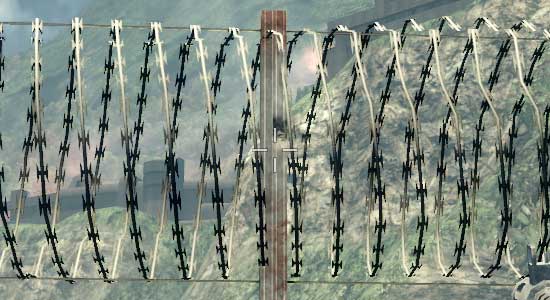
Bad Company 2 DX11 With Transparency Supersampling
The bad news is that it’s not quite complete. Oh as you’ll see in our screenshots it works, but the performance hit is severe. It’s currently super-sampling too much, resulting in massive performance drops. NVIDIA is telling us that this should be fixed next month, at which time the performance hit should be similar to that of the old TrSS mode under DX9. We’ve gone ahead and taken screenshots and benchmarks of the current implementation, but keep in mind that performance should be greatly improving next month.
So with that said, let’s look at the screenshots.

| NVIDIA GeForce GTX 480 | NVIDIA GeForce GTX 285 | ATI Radeon HD 5870 | ATI Radeon HD 4890 |
| 0x | 0x | 0x | 0x |
| 2x | 2x | 2x | 2x |
| 4x | 4x | 4x | 4x |
| 8xQ | 8xQ | 8x | 8x |
| 16xQ | 16xQ | DX9: 4x | DX9: 4x |
| 32x | DX9: 4x | DX9: 4x + AAA | DX9: 4x + AAA |
| 4x + TrSS 4x | DX9: 4x + TrSS | DX9: 4x + SSAA | |
| DX9: 4x | |||
| DX9: 4x + TrSS |
With the exception of NVIDIA’s new TrSS mode, very little has changed. Under DX10 all of the cards produce a very similar image. Furthermore once you reach 4x MSAA, each card producing a near-perfect image. NVIDIA’s new TrSS mode is the only standout for DX10.
We’ve also include a few DX9 shots, although we are in the process of moving away from DX9. This allows us to showcase NVIDIA’s old TrSS mode, along with AMD’s Adapative AA and Super-Sample AA modes. Note how both TrSS and AAA do a solid job of anti-aliasing the foliage, which makes it all the more a shame that they haven’t been available under DX10.
When it comes to performance, keep in mind that both AMD and NVIDIA have been trying to improve their 8x MSAA performance. When we reviewed the Radeon 5870 back in September we found that AMD’s 8x MSAA performance was virtually unchanged, and 6 months later that still holds true. The performance hit moving from 4x MSAA to 8x MSAA on both Radeon cards is roughly 13%. NVIDIA on the other hand took a stiffer penalty under DX10 for the GTX 285, where there it fell by 25%. But now with NVIDIA’s 8x MSAA performance improvements for Fermi, that gap has been closed. The performance penalty for moving to 8x MSAA over 4x MSAA is only 12%, putting it right up there with the Radeon cards in this respect. With the GTX 480, NVIDIA can now do 8x MSAA for as cheap as AMD has been able to
Meanwhile we can see the significant performance hit on the GTX 480 for enabling the new TrSS mode under DX10. If NVIDIA really can improve the performance of this mode to near-DX9 levels, then they are going to have a very interesting AA option on their hands.
Last but not least, there’s anisotropic filtering quality. With the Radeon 5870 we saw AMD implement true angle-independent AF and we’ve been wondering whether we would see this from NVIDIA. The answer is no: NVIDIA’s AF quality remains unchanged from the GTX200 series. In this case that’s not necessarily a bad thing; NVIDIA already had great AF even if it was angle-dependant. More to the point, we have yet to find a game where the difference between AMD and NVIDIA’s AF modes have been noticeable; so technically AMD’s AF modes are better, but it’s not enough that it makes a practical difference
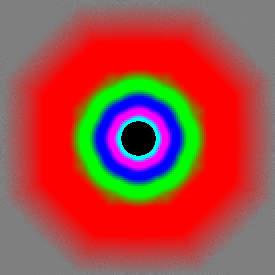
GeForce GTX 480

GeForce GTX 285
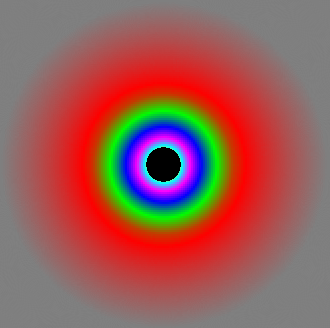
Radeon 5870


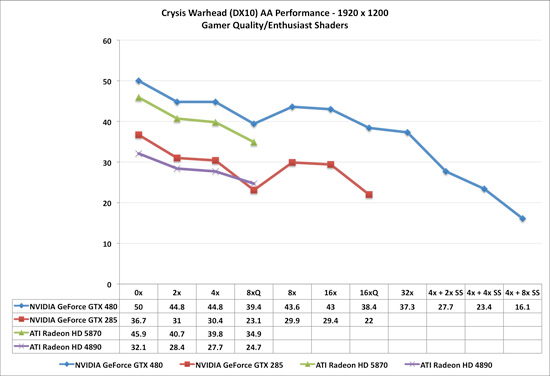
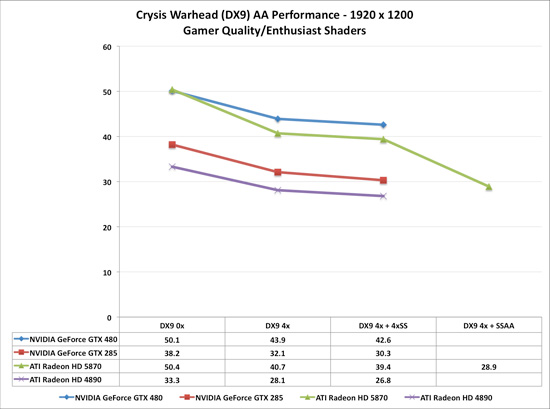








196 Comments
View All Comments
Saiko Kila - Sunday, March 28, 2010 - link
These MSRPs are not entirely, I mean historically correct... The first MSRP (list price) for HD 5850 was $259, and that was price you had to pay when buying on sites like newegg (there were some rebates, and some differences depending on manufacturer, but still you had to have a very potent hunting sense to get a card of any manufacturer, I got lucky twice). Shortly after launch (about one month, it was October) the MSRP (set by AMD) hiked to $279 and problems with supply not only continued but even worsened. Now, since November 2009, it's $299. HD 5870 followed generally similar path, though HD 5850 hiked more, which is no wonder. Note that this is for reference design only, some manufacturers had higher MSRPs, after all AMD or nvidia sell only chips and not gaming cards.If you believe anandtech, here you've got a link, the day the cards were announced:
http://www.anandtech.com/video/showdoc.aspx?i=3643">http://www.anandtech.com/video/showdoc.aspx?i=3643
The whole pricing things with HD 5xxx series is quite unusual (though not unexpected) since normally you'd anticipate the street price to be quite lower than MSRP, and then to drop even further, and you would be right. I remember buying EVGA GTX260 just after its launch and the price was good $20 lower than suggested price. That's why we need more competition, and for now the outlook isn't very bright, with nvidia not quite delivering...
And these European prices - most if not all European countries have a heavy tax (VAT), this tax is always included and you have to pay it, there are other taxes too. In the US the sales tax is not included in the street price, and usually you can evade it after all (harder for Californians). Europeans usually get higher prices. Comparing US prices is thereby better, particularly in us dollars (most electronics deliveries are calculated in dollars in Europe). So the prices in the rest of the world were also boosted, even in Europe, despite weak dollar and other factors :)
One note - HD5xxx cards are really very big and most of them have very unfriendly location of power sockets, so you'd expect to pay more for a proper, huge case. Also note that if you have a 600 W PSU or so you'd be smarter to keep it and not upgrade, unless REALLY necessary. The lower load means lower efficiency, especially when plugged to 115V/60Hz grid. So if you have a bigger PSU you pay more for electricity. And it seems that more gamers are concerned with that bill than in any time before... You couldn't blame them for that and it's sad in its own way.
LuxZg - Tuesday, March 30, 2010 - link
Well, current MSRP is like I wrote it above. If there is no competition and/or demand is very high, prices always tend to go up. We're just lucky it's not happening often because in IT competition is usually very good.As for European prices, what do taxes have to do with it? We've got 23% taxes here, but it's included in all prices, so if nVidia goes up 23% so do AMD cards as well. If I'm looking at prices in the same country (and city, and sometimes store as well), and if nVidia is 300$ and ATI is 100 and 500, than I just can't compare them and say "hey, nVidia is faster than this 100$ ATI card, I?ll buy that"... no, you can't compare like that. Only thing you can do in that case is say something like "OK, so I have 300$ and fastest I can afford is nVidia" .. or "I want fastest there is, and I don't mind the cost" and you'll take HD5970 than. Or you can't afford any of those. So again, I don't get why cards in this review are so rigidly compared one to another as if they have exact same price (or +/- 10$ difference). And at one hand they compare MORE expensive nVidia card to QUITE CHEAPER AMD card, but won't compare that same nVidia card to a more expensive AMD card.. WHY?
And AMD cards are no bigger than nVidia ones, and last time I've checked bigger case is way way cheaper than a new PSU. And I'm running my computer on, get this, 450W PSU, so I'm not wasting any excessive power on inefficiences on low loads ;) And since this PSU keeps overclocked HD4890, it should work just fine with non-overclocked HD5870. While I'm pretty sure that GTX470 would already mean a new PSU, new PSU that costs ~100$/80€ .. So I'd pay more $ in total, and get a slower card.
Again, I'm not getting why there's such a rigid idea of GTX470=HD5850 & GTX480=HD5870 ..
LuxZg - Saturday, March 27, 2010 - link
Just re-read the conclusion.. something lacks in this sentence:"If you need the fastest thing you can get then the choice is clear, .."
Shouldn't it finish with "... choice is clear, HD5970..." ? That's what I'm saying, HD5970 wasn't mentioned in the entire conclusion. Past are the days of "single-GPU crown" .. That's just for nVidia to feel better. ATI Doesn't want "single GPU crown", they want the fastest graphics CARD. And they have it.. Serious lack in this article, serious.. And again, there is exact same amount of money dividing GTX480 and HD5870, as is between GTX480 and HD5970..
blindbox - Saturday, March 27, 2010 - link
I know this is going to take quite a bit of work, but can't you colour up the main cards and its competition in this review? By main cards, I mean GTX 470, 480 and 5850 and 5870. It's giving me a hard time to make comparison. I'm sure you guys did this before.. I think.It's funny how you guys only coloured the 480.
PS: I'm sorry for the spam, my comments are not appearing, and I'm sorry for replying to this guy when it is completely off topic, lol.
JarredWalton - Saturday, March 27, 2010 - link
Yes, it did take a bit of work, but I did it for Ryan. The HD 5870/5970 results are in orange and the 5850 is in red. It makes more of a difference on crowded graphs, but it should help pick out the new parts and their competition. I'm guessing Ryan did it to save time, because frankly the graphing engine is a pain in the butt. Thankfully, the new engine should be up and running in the near future. :-)Finally - Saturday, March 27, 2010 - link
Further improvement idea:Give the dual-chip/SLI cards also another colour tone.
lemonadesoda - Sunday, March 28, 2010 - link
No. Keep colouring simple. Just 3 or 4 colours max. More creates noise. If you need to highlight other results, colour the label, or circle or drop shadow or put a red * a the end.Just NO rainbow charts!
IceDread - Tuesday, March 30, 2010 - link
The article does not contain hd 5970 in CF. The article does not mention the hd 5970 at all under conclusion. This is really weird. It is my belief that anandtech has become pro nvidia and is no longer an objective site. Obejtivity is looking at performance + functionality / price. HD 5970 is a clear winner here. After all, who cares if a card has 1, 2 or 20 gpus? It's the performance / price that matters.Kegetys - Tuesday, March 30, 2010 - link
According to a test in legitreviews.com having two monitors attached to the card causes the idle power use to rise quite a bit, I guess the anand test is done with just one monitor attached? It would be nice to see power consumption numbers for dual monitor use as well, I dont mind high power use during load but if the card does not idle properly (with two monitors) then that is quite a showstopper.Ryan Smith - Wednesday, March 31, 2010 - link
I have a second monitor (albeit 1680) however I don't use it for anything except 3D Vision reviews. But if dual monitor power usage is going to become an issue, it may be prudent to start including that.